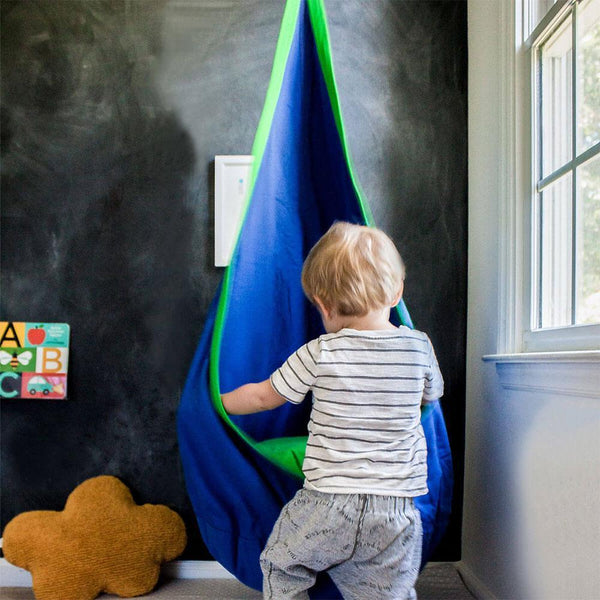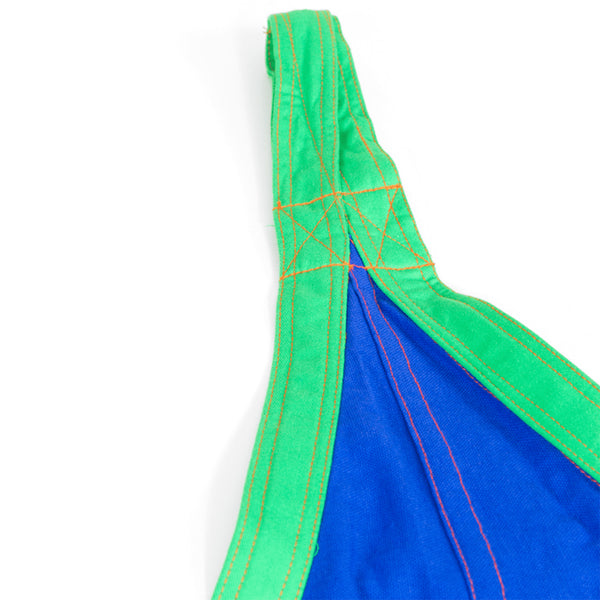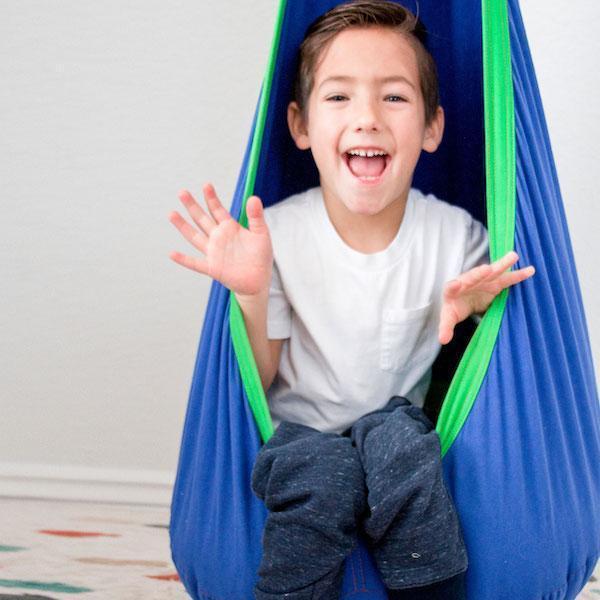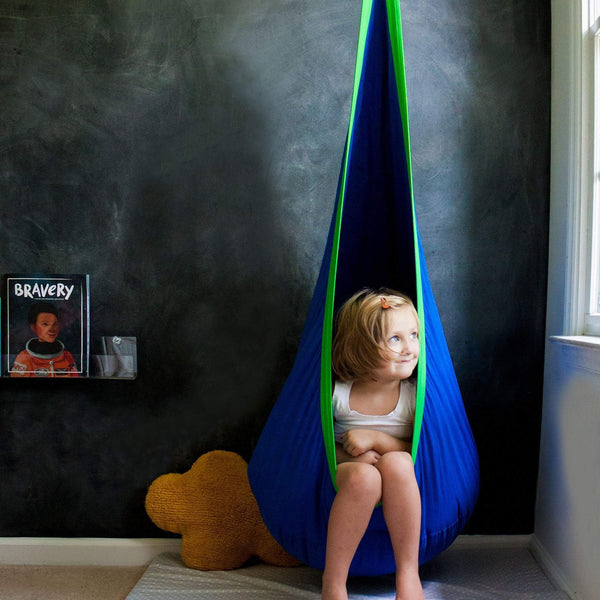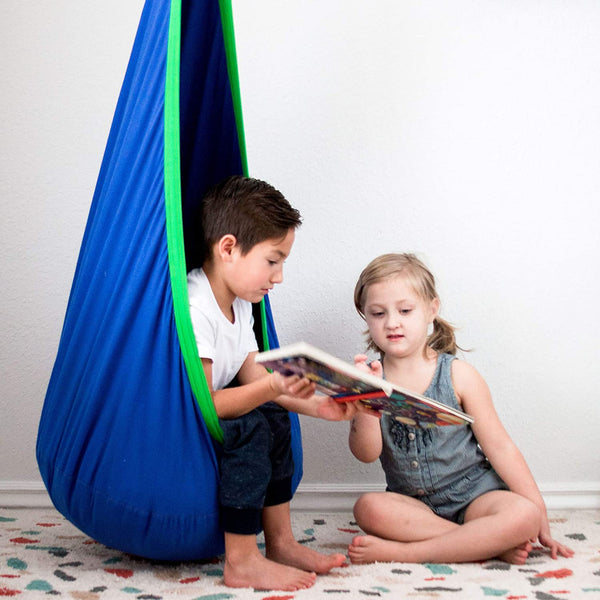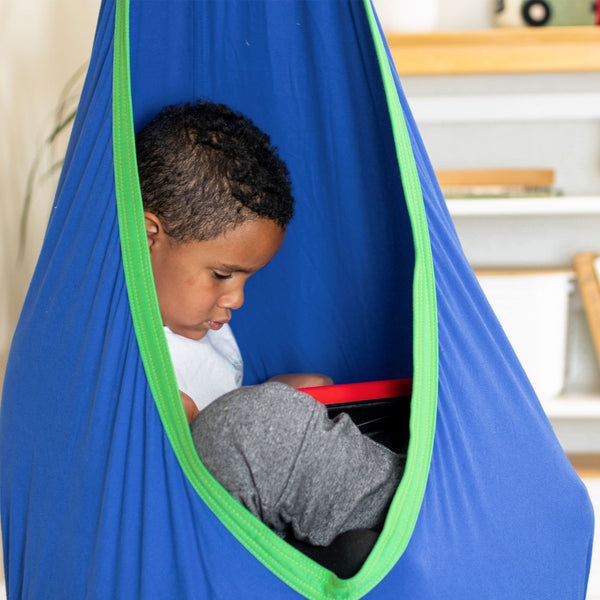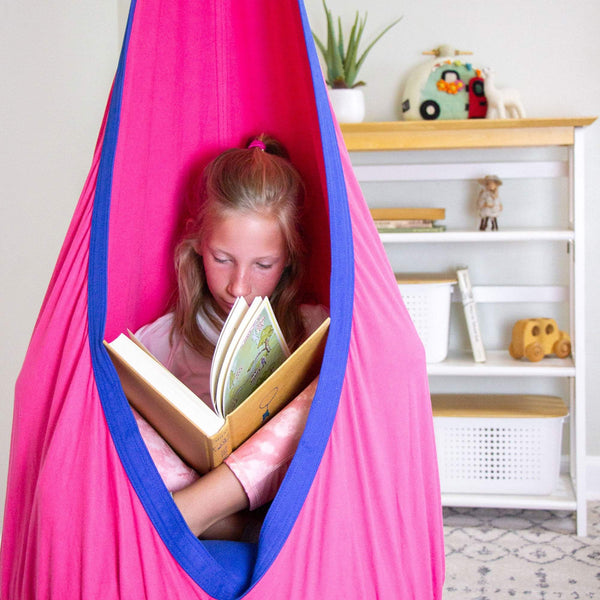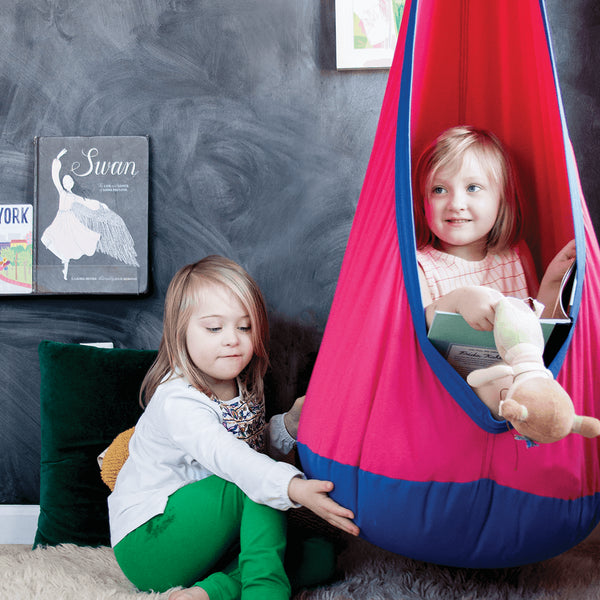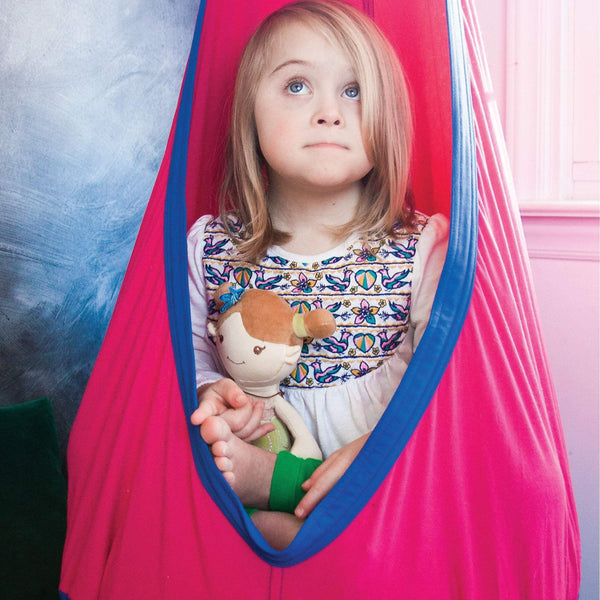Description If you are looking for a sensory or therapy swing to help your child relax and get their bearings, you’ve come to the right spot. Our sensory swings are made of high-quality but comfortable canvas your child will want to spend hours in.
Our Sensory Pod Swings are used by occupational therapists for autism spectrum disorder and sensory processing disorder. The Pod Sensory Swing provides a hug-like effect for little ones by providing Deep Touch Pressure (DTP). The Pod Sensory Swing also provides vestibular input. From infancy through adulthood, vestibular information contributes to the development of muscle tone, balance, eye movements, and more. Using slow, linear movements (back and forth, side to side), the Pod Sensory Swing gives much-needed vestibular input and creates a feeling of calm in your child.
However, many families purchase them simply because they are a fun place for your child to hang out!
Since our indoor therapy swing safely hangs from your ceiling, your child can receive the calming sense of well-being that swinging brings right in your home.
Details MATERIALS:
Exterior: Strong but Comfortable Canvas
Inflatable Seat Cushion: Plastic
MEASUREMENTS:
Swing Dimensions:
24 inches x 24 inches x 60 inches
Inflatable Seat Cushion Dimensions:
24 inches x 24 inches
WEIGHT:
2.5lbs
WHAT'S INCLUDED:
Pod Sensory Swing
Inflatable Seat Cushion
Manual Pump
Ceiling Hook
4 Bolts
2 Locking Carabiners
Daisy Chain
Who We Are We think children with special needs should have every opportunity to live happy and healthy lives. That's why Harkla is dedicated to providing families with the best products and resources for raising a special needs child. Read more of our story here.
FAQS Is There A Height Or Weight Limit For The Hanging Pod Swing?
The recommended weight limit for the Pod Sensory Swing is 150lbs . The recommend age limit for the Pod Sensory Swing is 3 years or older, though the swing is a small space by design. Therefore, we find the average maximum age for the Pod Swing to be 8 years old, but it is really a matter of comfort.
Can I Hang The Sensory Swing Outside?
Yes! With our adjustable strap and hardware, this swing can be hung almost anywhere and is not just a sensory room swing. Wherever you are hanging it from, make sure it's strong enough for a child to play on and allows the swing to be close to the ground.
Does The Pod Swing Work With Tall Ceilings?
Yes, we send an adjustable strap with the swing that allows you to hang this autism swing with almost any normal ceiling height.
Where Do We Ship This Product?
From the Harkla Website, we only ship this product to the United States.
However, if you are looking for us in another country, we have options for purchasing!
Canada: Shop our store on Amazon Canada
Australia: Shop for us with our Australian Partner Starfish
If you're looking for another country, please check out our partner page to see if our products are available in your country through another retailer!
If you’d like to be informed of when we will be shipping to your country, please contact our customer service: support@harkla.co
Related Articles What is the pod sensory swing?
The pod sensory swing from Harkla is an enclosed swing with an inflatable seat cushion that provides vestibular input while also providing a safe space to swing independently.
Who can benefit from the pod sensory swing?
The pod sensory swing was created with sensory in mind, meaning children (and adults!) who struggle with sensory processing are the main beneficiaries of the pod sensory swing.
Let’s break it down a bit more.
If a child is struggling with vestibular processing - they seek out movement that interferes with daily activities, they are clumsy or uncoordinated, or they get motion sickness - then the pod sensory swing can be a great tool!
If a child is struggling with proprioceptive processing - they seek out heavy work (such as pushing, pulling, jumping), they use too much force with tasks such as writing or playing, or they struggle with understanding where their body is in space (may seem clumsy or get hurt often) - then the pod sensory swing can be a great addition to their play items!
If a child is struggling with self-regulation and attention - they get frustrated easily, they cannot sit and attend to a task for an age-appropriate amount of time, or they are unable to solve problems that are age-appropriate - then the pod sensory swing can be a great tool!
If a child has a diagnosis or signs/symptoms of ADHD/ADD, Autism, Down Syndrome, Developmental Delay, cognitive/learning challenges, Apraxia, SPD, or speech/language delay, the pod sensory swing can be a great addition to their play and development.
Different Types of Sensory Inputs Provided by the Pod Swing
The pod sensory swing provides two main sensory inputs: proprioception and vestibular.
Proprioception Input:
Proprioception is the awareness of the position and movement of the body. Sensory receptors are located on your skin, joints, and muscles. These sensory receptors send signals to our brain when we move, telling it about the movement's effort, force, and heaviness. Then our body can provide an appropriate response.
Vestibular Input:
The vestibular system is located in the inner ear. This system is directly related to balance and vision - specifically eye movements. Because of the location in the inner ear, the vestibular system is activated with head movements. When the head moves, the eyes move, and the brain and body must provide a response - balance!
When we think about vestibular input, we can think about running, jumping, spinning, and swinging. These movements activate the vestibular system and will provide a response - some people can tolerate more movement than others, while some become easily nauseous with movement (motion sickness). Vestibular input is typically alerting to the nervous system.
The pod sensory swing provides vestibular input because it’s a swing! Depending on how you position your body in the swing, you can receive linear vestibular input - back and forth or side to side, or rotary vestibular input - spinning.
Some individuals become easily over-stimulated by vestibular input. This can cause adverse reactions such as nausea/vomiting or irritability (among others). Some individuals seek vestibular input - constantly on the move, seeking out opportunities to spin and jump.
Because the pod sensory swing provides both proprioceptive and vestibular input, it can be used to achieve a sense of calm or to achieve a higher arousal level.
Another Added Benefit
Another area that the pod sensory swing adds to is body awareness and spatial relations. When we complete an activity that provides both proprioception and vestibular, our ability to better understand our body in space and within our environment improves. This has the added benefit of improving safety, coordination, and motor planning!
Tips For Introducing The Pod Sensory Swing to Your Child
If your child is unsure about the pod sensory swing, try these tips to engage them:
- Model! Get in the swing and show your child how to swing slowly. Let your child watch you have fun in the swing. Allow your child to give you a push in the swing.
- Place favorite toys in the swing and allow your child to swing their toys first.
- Suspend the swing closer to the ground so that your child is not as high off the ground.
- Allow your child to maintain a sitting position rather than laying down; it’s a lot scarier (aka more vestibular input) to lay down with legs unsupported.
- Never force your child to get in the swing unwillingly. It will take them longer in the long run if we push them!
- Avoid pressuring your child to get in the swing as well. This includes positive pressure (i.e., “If you get in the swing, you can have a piece of chocolate!”). Hang it up, let them explore, walk away (if safe), and when they get in on their own, don’t make a big deal about it! Just talk to them calmly about how it feels, what they think, etc.
- Put crash pads, couch cushions, a bean bag chair, pillows, and blankets under the swing to offer a safe landing if they want to crash and fall out on purpose.
Tips for Incorporating the Pod Sensory Swing into Your Child’s Day
Incorporating the pod sensory swing into your child’s daily routine can help with self-regulation throughout the day and add a play element into the day. Here are some tips for incorporating the swing into your child’s routine:
- Add the swing to the morning routine to help “wake up.”
- Use the swing as a “brain break” in between school/homework.
- Offer the swing after school, before getting started on homework, chores, or extracurricular activities to reset the nervous system.
- Use the swing as part of a sensory diet to help with arousal level.
- Allow your child to swing independently to de-stress or calm down when upset.
- Follow swinging with heavy work/deep pressure proprioceptive input activities to help reduce overstimulation.
- Activities like bear crawling, wheelbarrow walking, jumping jacks, crashing on a crash pad or couch, wall push-ups, chewing gum (if safe) will help.
- Use a visual timer to include a start and stop. “First, we’re going to swing for 3 minutes, and then we’re going to do 30 seconds of bear crawling.”
Final Thoughts on Harkla’s Pod Sensory Swing
The pod sensory swing can be a great addition to your child’s bedroom, playroom, or living room. There are so many ways to utilize the swing to help your child with self-regulation, sensory processing and integration, body awareness, and more!
Click the title below to learn more about Harkla Therapy Swings:



